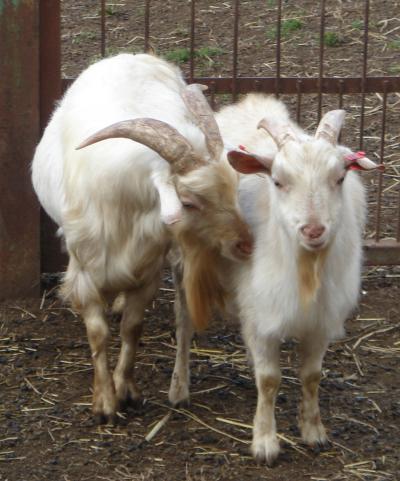Male Goat's 'Goaty' Pheromone Puts Females in the Mood

There is more to that characteristic "goaty" odor of male goats than one may think (or smell). It turns out, a male goat's scent is powerful enough to get female goats in the mood.
New research has identified a pheromone in the hair of male goats that activates a hormone in female goats called gonadotropin-releasing hormone, which stimulates their reproductive systems. The pheromone is called 4-ethyloctanal.
"In 4-ethyloctanal, we identified a novel chemical that had never been demonstrated in nature before. This was our first surprise," study author Yukari Takeuchi, of the University of Tokyo, said in a statement.
The researchers also found that when 4-ethyloctanal reacts with oxygen, it converts to a related compound called 4-ethyloctanoic acid, which is the main ingredient of the goaty odor that plays a crucial role in attracting females to males. [Animal Sex: 7 Tales of Naughty Acts in the Wild]
In other words, it seems this single molecule alters both female goats' behavior, and their reproductive systems, Takeuchi said. The researchers think this may be "a clever reproductive strategy of the male goat," he said.
Researchers knew for a long time that in sheep and goats, the males somehow stimulated the release of reproductive hormones in females, but now the new study has identified the actual compound at work, said John J. McGlone, a Texas Tech University professor, who was not involved in the study.
"I think it is pretty convincing that they have identified the compound," McGlone said.
Sign up for the Live Science daily newsletter now
Get the world’s most fascinating discoveries delivered straight to your inbox.
There are thousands of insect pheromones, and there are probably at least hundreds, if not thousands, of mammalian pheromones, but only 15 to 20 mammalian pheromones have been identified, he said.
Identifying them is tough, however, thanks to the use of modern technology it is becoming easier, McGlone told Live Science.
The research may have implications for species other than goats, he said. "When there is a pheromone in one species, what we are learning is that it often has effects on other species."
For instance, there is a pig pheromone that stops dogs from barking, McGlone said.
The new goat pheromone could even have an effect on humans, he said, but he noted the olfactory systems of different species can respond differently to the same pheromone.
The new study illustrates fundamental differences between the ways in which humans and animals interact with their environments.
"Where we see the world primarily through sight and sound, and then touch and a little bit of smell, they see their world primarily through their sense of smell," McGlone said. "They are sensing things in the environment that we can't sense."
Follow Agata Blaszczak-Boxe on Twitter . Follow Live Science @livescience, Facebook & Google+. Original article on Live Science.









